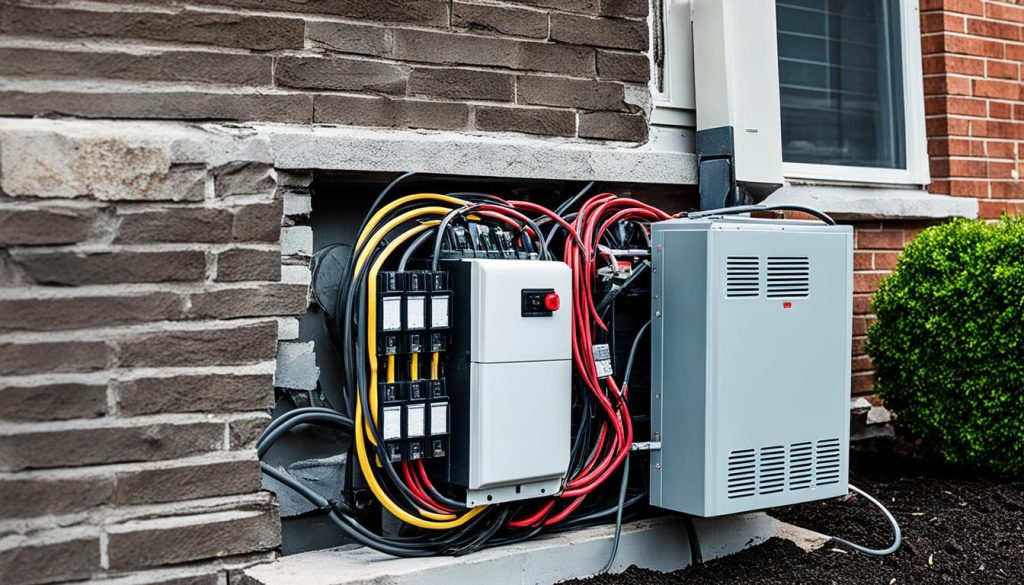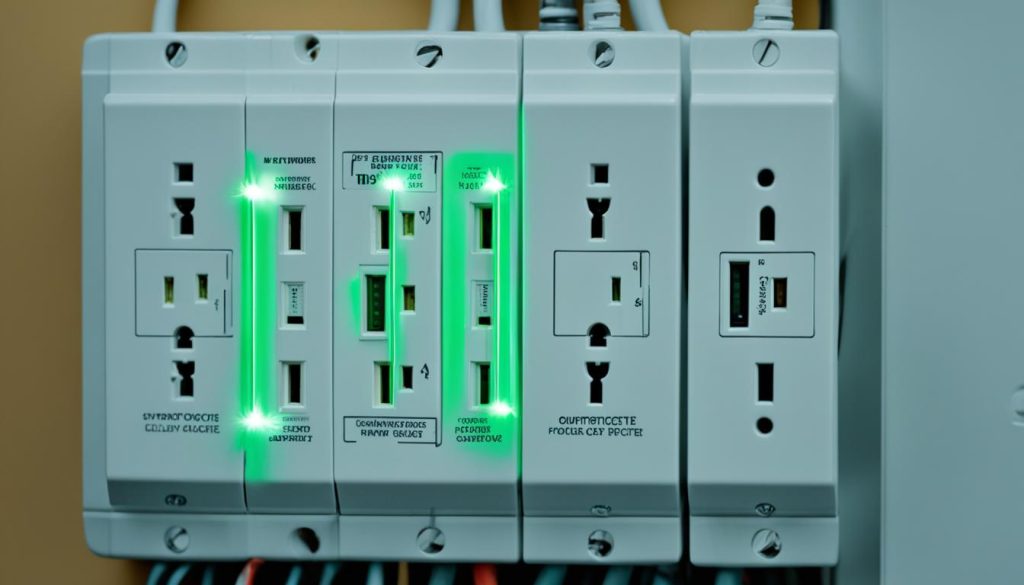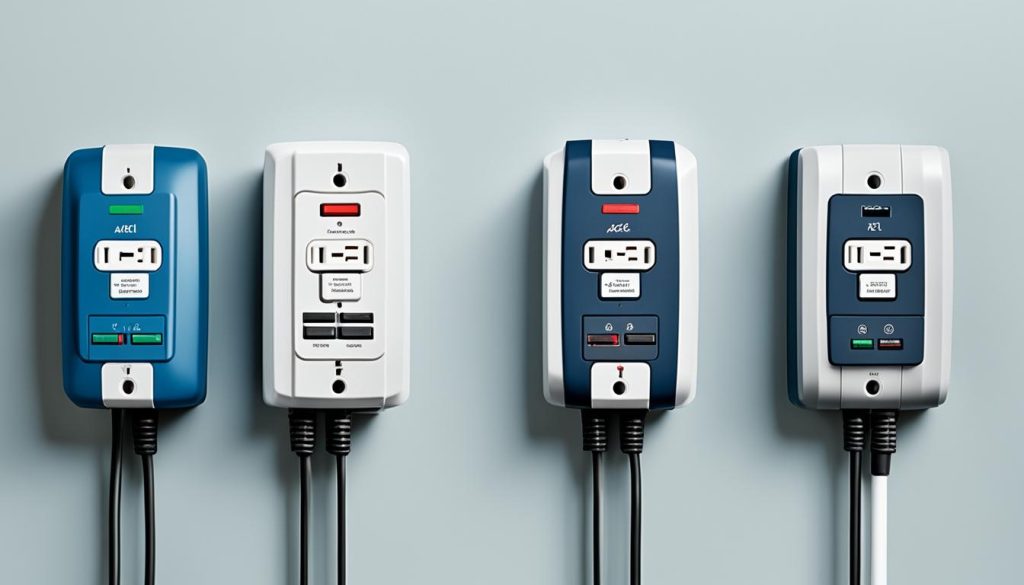A whole-house surge protector is an essential device for protecting your home and electrical systems from the damaging effects of power surges. But how exactly does it work? Let’s take a closer look.
When an electrical surge occurs, whether it’s from a lightning strike, power outage, or other sources, it can send an overwhelming amount of voltage through your home’s electrical system. This surge of electricity can damage sensitive electronics, appliances, and even start electrical fires.
A whole-house surge protector is installed at your home’s electrical panel and acts as a filter, allowing safe electrical current to flow while blocking dangerously high voltage. It works by diverting excess voltage or current into the ground through a dedicated ground wire when it senses a surge. By doing this, it protects your home’s electrical system from being overloaded and prevents damage to your valuable equipment.
It’s important to note that while a whole-house surge protector provides valuable protection, it cannot stop all surges. Surge protectors have a specified voltage protection rating (VPR), and anything above this rating may still pass through. That’s why it’s recommended to layer your surge protection by using point-of-use surge protectors or built-in surge protector outlets.
Key Takeaways:
- A whole-house surge protector connects to your home’s electrical panel and diverts excess voltage into the ground during a surge.
- It protects appliances, electronics, and the entire electrical system of your home.
- Installing a whole-house surge protector provides peace of mind and safeguards against electrical fires.
- While it is an investment, the cost is worth it compared to potential damage to expensive equipment.
- Layering surge protection with point-of-use protectors enhances overall protection from surges.
Advantages of Whole-House Surge Protection
Whole-house surge protection offers several advantages. Firstly, it protects your home’s appliances, including electronics, refrigerators, HVAC systems, smartphones, and more. It reacts quickly to turn away excess current or voltage during a power surge, preventing dangerous voltage levels from entering your home and damaging your appliances.
Secondly, it protects your home’s electrical system, including wiring, sockets, and circuits. By preventing electrical surges from entering your home, it avoids the need to replace damaged electrical wiring, which can be a costly expense. This ensures the longevity and reliability of your entire electrical infrastructure.
Lastly, whole-house surge protection provides peace of mind. Knowing that your home and its appliances are protected from expensive damage caused by electrical surges can give you a sense of security and relief. Surges can happen unexpectedly, and the consequences can be devastating. With whole-house surge protection, you can rest easy knowing that you’ve taken the necessary steps to safeguard your home.
| Advantages | Description |
|---|---|
| Appliance protection | Prevents damage to electronics, refrigerators, HVAC systems, and smartphones by diverting excess current or voltage during power surges. |
| Electrical system protection | Protects wiring, sockets, and circuits from damage caused by electrical surges, avoiding the need for costly repairs or replacements. |
| Peace of mind | Provides reassurance and a sense of security, knowing that your home and appliances are safeguarded against electrical surges. |
Disadvantages of Whole-House Surge Protection
While installing a whole-house surge protector offers numerous benefits, it’s important to consider the potential drawbacks as well. Here are two key disadvantages to keep in mind:
- Investment: One significant disadvantage is the initial cost of installing a whole-house surge protector. The price can range from $500 to $750+ depending on factors such as the device’s type, brand, and the electrical setup of your home. Although this may seem like a sizable investment, it is important to remember that it is a one-time expense. Plus, it can potentially save you thousands of dollars by protecting your valuable electrical equipment from damage caused by surges.
- Not Stopping All Surges: Another important consideration is that whole-house surge protectors are not capable of stopping all surges. These devices have a specified voltage protection rating (VPR), which determines the maximum voltage they allow to pass through to your home’s electrical system. While it is recommended to choose a whole-house surge protector with a low VPR, it is crucial to also implement additional surge protection measures. Layering surge protection by using point-of-use surge protectors or built-in surge protector outlets can provide an extra level of protection for your sensitive electronics and appliances.
It’s essential to weigh these disadvantages against the benefits when considering whether to install a whole-house surge protector in your home.

Understanding Whole-Home Surge Protection
A power surge is a sudden increase in electricity flowing through a circuit, which can have detrimental effects on the home’s wiring, outlets, switches, and electrical appliances. Lightning strikes, downed power lines, and fluctuations in electricity usage can all contribute to power surges. It is crucial to understand whole-home surge protection to safeguard your electrical system and appliances from potential damage.
At the core of whole-home surge protection is the surge protector, a device designed to continuously monitor the voltage of the current entering the home and within the electrical system. When it detects a dangerous increase in voltage, the surge protector diverts the excess voltage to the ground wire, effectively grounding the power and preventing it from flowing through the electrical system.

Surge protectors act as pressure-relief valves, shielding your home’s electrical system and appliances from the harmful effects of power surges. By diverting excess voltage, surge protectors ensure that only safe levels of electricity flow through your electrical system, mitigating the risks of damage and costly repairs.
There are different types of surge protectors available:
- Whole-house suppressors: These surge protectors are hard-wired to your home’s electrical panel and provide protection to your entire electrical system. They are equipped with a specified voltage protection rating (VPR) and may come with additional features such as thermal fuses and failure-indicator lights.
- Point-of-use surge protectors: These plug-in devices offer localized protection to specific appliances or electronic devices. They are designed to meet UL Standard 1449, with a clamping voltage of 400 volts or less and the capacity to absorb a minimum of 600 joules of energy.
- Uninterruptible power supplies (UPS): These surge protectors not only provide surge protection but also offer clean, fluctuation-free power and battery backup during power outages.
It’s essential to understand the specific needs of your home and its electrical system when choosing the right type of surge protector. Consider consulting with a licensed electrician to determine the most suitable option for your requirements.
By implementing whole-home surge protection, you can minimize the risks associated with power surges and protect your electrical system and appliances from potential damage. Remember that while surge protectors offer valuable protection, they cannot guard against all types of surges. Consider layering your surge protection by using a combination of whole-home and point-of-use surge protectors for comprehensive coverage.
Types of Surge Protectors
When it comes to protecting your home and electrical devices from power surges, there are different types of surge protectors to choose from. Understanding the differences between these surge protectors will help you make an informed decision based on your specific needs. The three main types of surge protectors are:
1. Whole-House Suppressors
Whole-house suppressors are installed directly into your home’s electrical panel and provide protection for the entire electrical system. These surge protectors are hard-wired and have the capability to handle large surges, such as lightning strikes or power line disturbances. They typically have a rating to stop at least a 40,000-amp surge and may come with additional features such as thermal fuses and failure-indicator lights. Whole-house suppressors offer comprehensive surge protection for your entire home, safeguarding all connected devices and appliances.
2. Point-of-Use Surge Protectors
Point-of-use surge protectors are plug-in devices that provide protection to specific appliances or electronic devices. These surge protectors are designed to be conveniently plugged into outlets near your valuable electronics, such as televisions, computers, or gaming consoles. They are equipped with features that meet UL Standard 1449, including a clamping voltage of 400 volts or less and the ability to absorb at least 600 joules of energy. Point-of-use surge protectors also protect all three incoming lines (hot, neutral, and ground) to ensure comprehensive safeguarding of your devices.
3. Uninterruptible Power Supplies (UPS)
Uninterruptible power supplies offer more than just surge protection. In addition to safeguarding against power surges, UPS devices provide clean, fluctuation-free power and battery backup during power outages. These devices are ideal for protecting sensitive electronics, such as servers, network equipment, or medical devices, that require a stable power supply. UPS devices often come with built-in surge protection and can be used for both home and professional setups where uninterrupted power is essential.
Choosing the right type of surge protector depends on your specific requirements and the level of protection you need for your home and devices. Whole-house suppressors offer comprehensive protection for your entire home, while point-of-use surge protectors and UPS devices provide targeted protection for specific appliances or electronics.

Installation and Cost of Whole-House Surge Protectors
When it comes to protecting your home and appliances from potentially damaging electrical surges, the installation of a whole-house surge protector is a wise investment. To ensure proper installation, it is recommended to hire a licensed electrician who will mount the device inside your home’s main electrical panel. This process typically takes around two hours and ensures that your entire electrical system is safeguarded against surges.
The cost of a whole-house surge protector can vary depending on several factors, including the type, brand, and the specific electrical and wiring setup of your home. On average, the device and professional installation can range from $500 to $750 or more. While this may seem like a significant upfront cost, it is important to consider the potential savings in electrical damage that a surge protector can provide.
In addition to protecting your home’s electrical system, it is also recommended to install separate whole-house units for phone and cable lines, as these connections are vulnerable to surges as well. By taking these extra precautions, you can ensure that all your connected devices are shielded from electrical spikes.
While there may not be direct discounts on home insurance premiums for surge-protected homes, the installation of a whole-house surge protector can offer peace of mind knowing that your valuable appliances, electronics, and electrical system are safeguarded. In the long run, the investment in surge protection can potentially save you thousands of dollars in electrical damage and provide added security for your home.
FAQ
How does a whole-house surge protector work?
A whole-house surge protector connects to the home’s electrical panel and acts as a filter to allow safe current while blocking dangerously high voltage. It diverts excess current or voltage into the ground through a ground wire when it senses an electrical surge.
What are the advantages of whole-house surge protection?
Whole-house surge protection protects appliances, including electronics and HVAC systems, by turning away excess current or voltage during a power surge. It also protects the entire electrical system of the house and provides peace of mind.
Are there any disadvantages of whole-house surge protection?
The installation cost can be relatively high, and whole-house surge protectors cannot stop all surges. It is recommended to layer surge protection using point-of-use surge protectors or built-in surge protector outlets.
How do power surges affect the electrical system and appliances?
Power surges can cause damage to the home’s wiring, outlets, switches, and electrical appliances. They can be caused by lightning strikes, downed power lines, and changes in electricity usage.
What are the different types of surge protectors?
There are three main types of surge protectors: whole-house suppressors, point-of-use surge protectors, and uninterruptible power supplies (UPS).
How much does it cost to install a whole-house surge protector?
The cost of installing a whole-house surge protector ranges from $500 to $750+ depending on the type, brand, and the home’s electrical setup.


